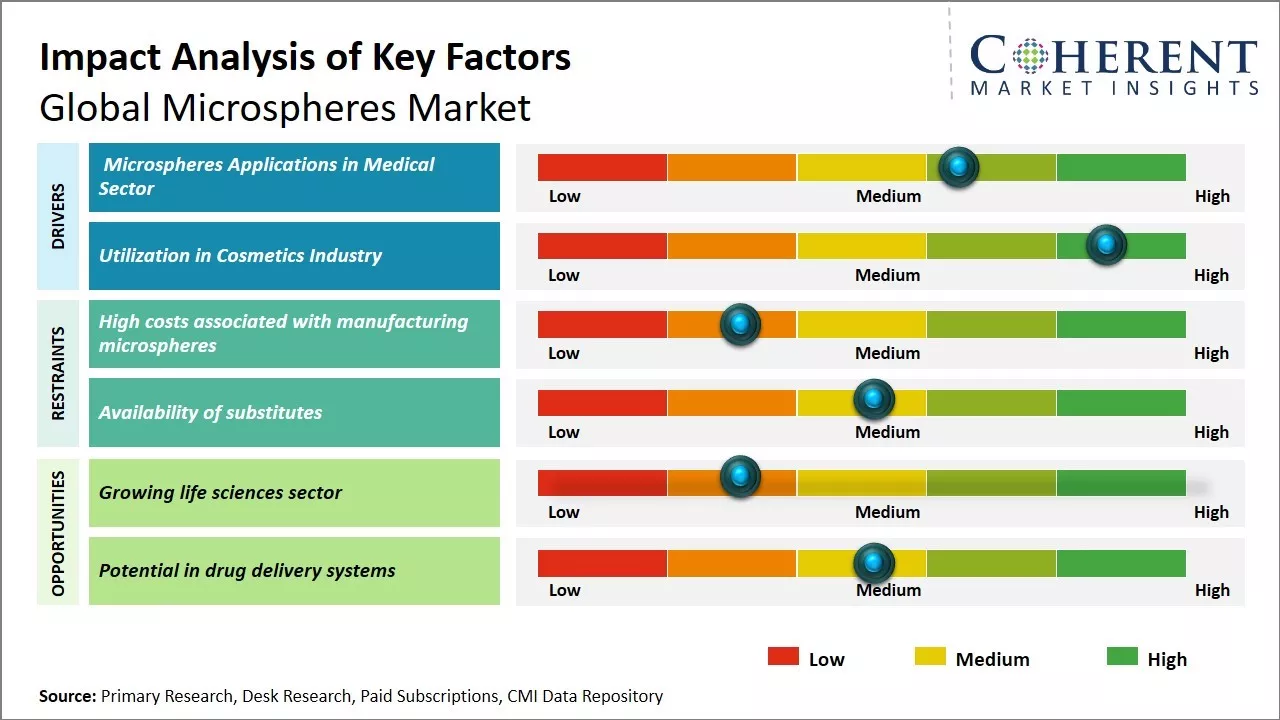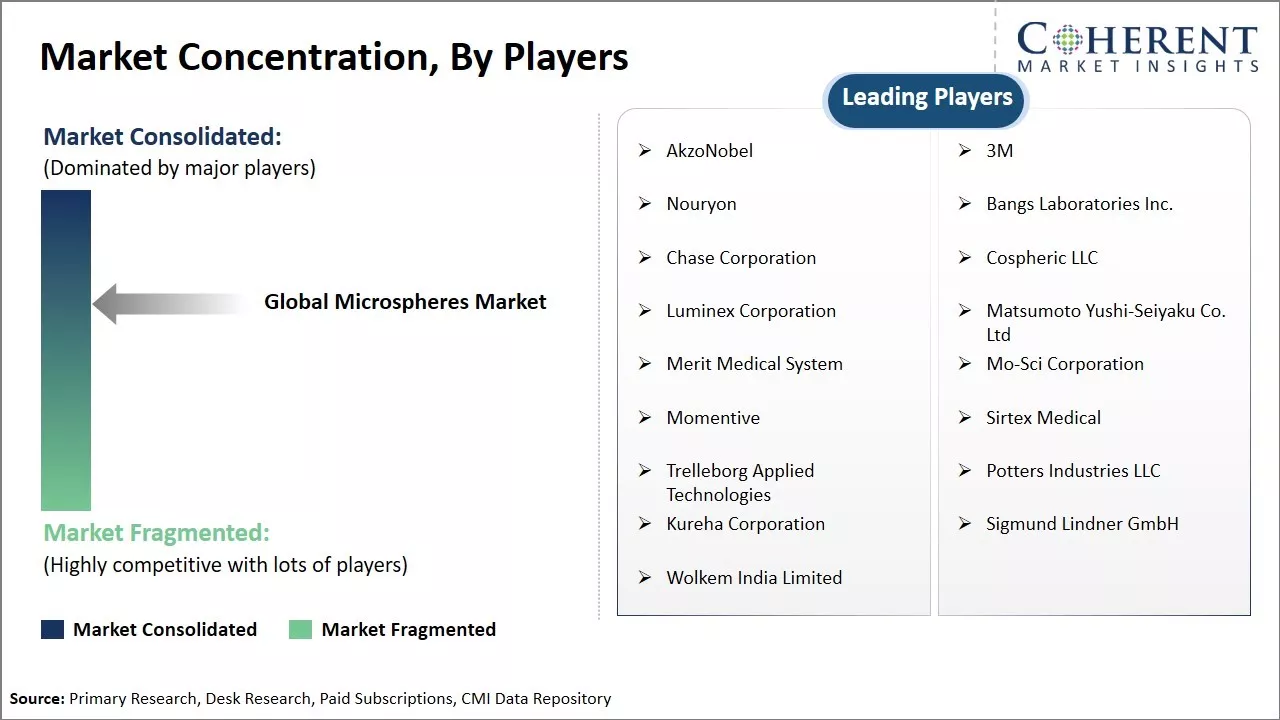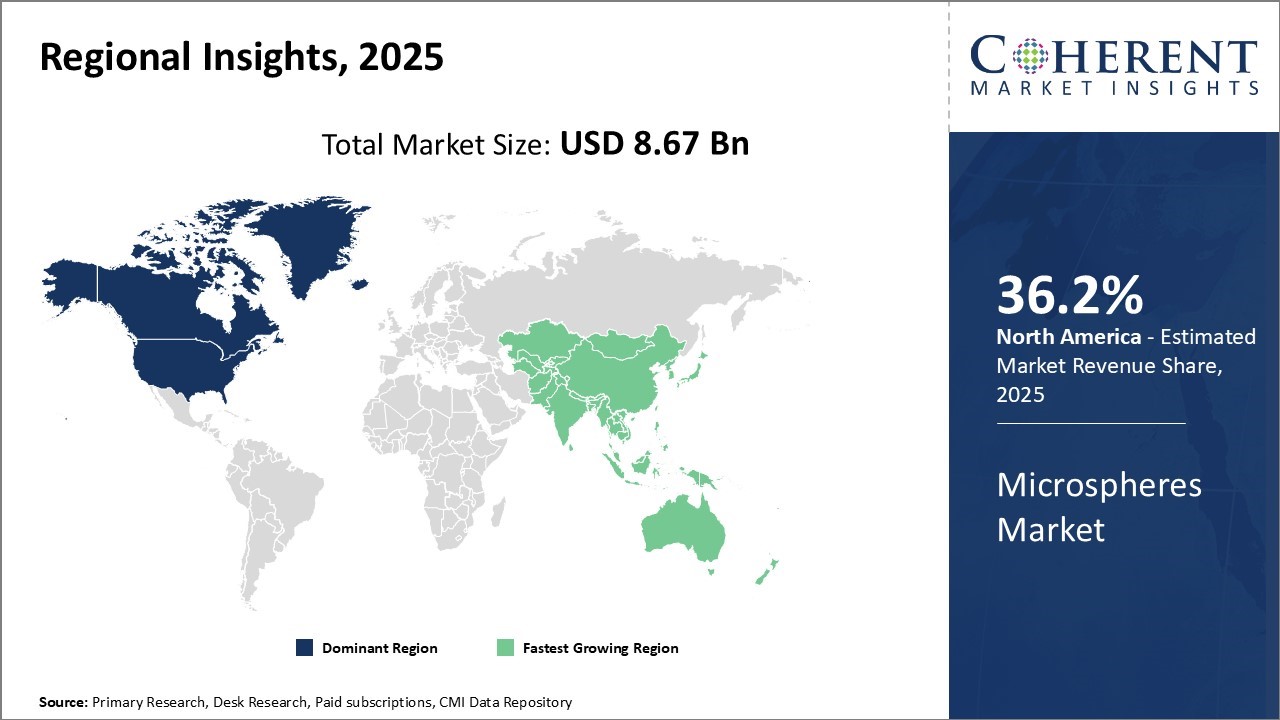The microspheres market is estimated to be valued at USD 8.67 Bn in 2025 and is expected to reach USD 16.16 Bn by 2032, growing at a compound annual growth rate (CAGR) of 9.3% from 2025 to 2032.

To learn more about this report, Download Free Sample
The microspheres market has been registering steady growth in recent years, driven by growing applications in pharmaceuticals, construction, aerospace, cosmetics, and medical devices. These spherical particles, ranging from hollow ones to solid ones consisting of such material as glass, ceramic, polymer, and biodegradable materials, are valued for their lightness, for the delivery of drugs under controlled conditions, and as performance-oriented functions in composites. Increasing use in high-end drug delivery, tissue engineering, and high-performance coatings is propelling demand even higher, particularly in life sciences and biotechnology.
|
Current Events |
Description and its impact |
|
Advanced Bio-Based and Functional Microspheres Development |
|
|
Integration of Smart Microspheres with Sensor and Diagnostic Functions |
|
Uncover macros and micros vetted on 75+ parameters: Get instant access to report
The extensive use of microspheres in medical applications such as drug delivery, cell therapy, medical imaging, regenerative medicines, etc. is expected to boost the demand. Microspheres are increasingly replacing traditional drug delivery methods owing to their controlled release mechanism. Various biodegradable polymers are being used to develop microspheres which can encapsulate a wide range of drugs and deliver them precisely at the target site in a sustained manner. This ensures maximum drug utilization and minimum side effects.
In cell therapy, microspheres act as ideal carriers to administer stem cells for treating complex diseases like cardiovascular illnesses. The three-dimensional scaffold created by microspheres mimic the native extracellular matrix and provide conducive environment for cell proliferation. Researchers are also exploring the potential of magnetic microspheres loaded with drugs/cells which can be guided to target location inside the body using external magnetic field. This capability is poised to revolutionize the precision of medical treatments in future.
In 2024, PolyMicrospheres Inc. announced the commercial launch of their biodegradable microsphere platform designed for targeted drug delivery in oncology, enabling sustained release of chemotherapy agents with reduced side effects, marking a significant advancement in precision medicine.
The unique properties of microspheres make them extensively utilized as delivery systems and additives in cosmetic formulations such as creams, lotions, gels, etc. Microencapsulation allows controlled release of active ingredients, protects them from degradation and improves chemical stability of end products. Oil-based microspheres loaded with vitamins, antioxidants, or anti-ageing agents deliver nutrients beneath skin surface in a sustained manner.
Color cosmetics greatly leverage microsphere technology for long lasting pigments which disperse uniformly. Microspheres are also gaining prominence as texturizing agents to provide rich feel and improve spread-ability of cosmetic formulations. With rising health and aesthetic consciousness, demand for cosmetic products with high performance and novelty is growing rapidly worldwide.
Microspheres enable development of such advanced formulations. They help brands to launch new generation of skin care and color cosmetic products with superior benefits. Innovation is further fueled by ongoing R&D to produce biodegradable polymeric microspheres from natural polymers. The dual drivers of industry expansion and continual technology advancement will foster healthy demand for microspheres from cosmetic manufacturers globally in the coming years.
The growing life sciences sector is increasing the demand for tailored microspheres in drug delivery, vaccines, and medical imaging applications. As renewable energy technologies progress, microspheres offer potential solutions aiding concentration and insulation. Furthermore, advancement of 3D printing techniques relies on reliable microsphere inputs. Developing innovative production methods and partnering across industries can help producers capitalize on these expanding opportunities.

To learn more about this report, Download Free Sample
In terms of type, hollow microspheres are expected to contribute 71.4% share of the market owing to their extensive use in construction composites in 2025. Hollow microspheres are used as lightweight fillers in various construction materials such as cement, concrete, plasters, and others to reduce the overall weight without compromising on strength.
The hollow internal structure makes them many times lighter than conventional filler materials. Their use helps optimize the strength-to-weight ratio of composites. The ever-growing construction industry, particularly in developing economies, relies heavily on lightweight and high-strength building materials for commercial and residential construction.
Hollow microspheres address this need efficiently. Their increasing adoption allows for constructing taller yet sturdier structures using lesser raw materials. This supports sustainability goals as well. Various infrastructure development projects also employ composites containing hollow microspheres. The hollow structure provides insulation and protects against cracks.
In terms of raw material, glass dominates the market share due to its inherent advantages over other types, which is expected 38% of the market share in 2025. Glass microspheres can be manufactured to precise sizes and morphologies. They exhibit high sphericity and narrow particle size distribution. This makes them extremely useful as reinforcement fillers.
Glass does not degrade or corrode when used in composites. It withstands high temperatures and pressure very well. Since glass is inert and does not react chemically, it does not interfere with polymerization or curing reactions involved in composite synthesis. This facilitates uniform dispersion of glass microspheres into matrices without compromising the final product performance.
Their chemical resistance allows for end-use in demanding applications exposed to chemicals and solvents. Glass microspheres are also non-toxic and biocompatible. These properties have led to preferred adoption of glass over other raw materials in high-growth application segments.
Among application, healthcare and biotechnology capture the highest share due to intensive research in these areas, which is expected to 36.2% of the market share in 2025. Microspheres find widespread application as carriers for drug and gene delivery, tissue engineering, cell therapy, and other medical solutions. Their miniature, spherical shape with narrow size distribution allows for efficient encapsulation of active therapeutic molecules.
Functionalized microspheres can be targeted to specific body parts or cells. They help optimize dosage and maintain steady concentration of entrapped drugs. This improves efficacy and reduces side effects. Microspheres are being explored for developing advanced treatments for cancer, cardiovascular diseases, ophthalmic disorders, and more. Rising healthcare expenditure to address growing disease burden will further drive their demand from the biotechnology segment.

To learn more about this report, Download Free Sample
North America has established itself as the dominant region in the global microspheres market with and is expected to account for 36.2% of the market share in 2025. The presence of leading manufacturers and established end-use industries such as paints & coatings, healthcare & personal care, automotive, and oil & gas has propelled the market growth.
Major players like 3M, Trelleborg, and Luminex Corporation have their headquarters in the U.S., conferring it with an advantage in terms of production and technological capabilities. The demand for lightweight and specialty products from automotive and aviation industries has risen exponentially over the past decade. This has spurred the adoption of microsphere fillers and additives in North America.
Impressive growth in the application of microspheres within the personal care and medical sectors has further augmented the regional market size. The easy availability of raw materials and growth opportunities across industries will continue to drive North America's leadership.
Asia Pacific has emerged as the fastest expanding regional market for microspheres. Countries like China, India, Japan, and South Korea are influencing global manufacturing processes with their substantial industrial growth rates. Asia Pacific nations are rapidly industrializing and witnessing rising disposable incomes. This has increased the usage of various end-use materials incorporating microspheres in the region.
The strong international presence of domestic manufacturers has enabled Asia Pacific to become a prominent exporter of microsphere-based products. In addition, the regional emphasis on developing specialized and customized products has led to extensive research collaborations between industry players and academia. Such initiatives are helping new application areas and innovative production techniques to emerge, satisfying the evolving needs of global customers.
The U.S. dominates the world microspheres market because of its robust pharmaceutical, aerospace, and medical device sectors. Heavy investment in R&D and early embracement of complex drug delivery systems fuel demand for polymer and biodegradable microspheres. Support from regulations and existence of prominent players such as 3M and Thermo Fisher enhance its dominance.
Germany dominates the European microspheres market through innovation in automotive components, coatings, and biomedical engineering. Emphasis is placed on sustainable and lightweight materials in the nation, fostering expansion in hollow glass and ceramic microspheres. Strong manufacturing platform and academic partnerships also support market penetration.
Japan dominates in the production of high-purity ceramic and polymer microspheres for electronics, cosmetics, and precision coatings. Japan's leadership in miniaturized medical devices and semiconductors fuels demand for microspheres with enhanced narrow size distribution and surface control. Domestic companies focus on innovation and export-oriented production.
China is spearheading a strong penetration into the microspheres market, supported by capacity-intensive manufacturing equipment and rising domestic demand in pharmaceuticals, building construction, and coatings. Competitive pricing and government support for biotechnology and advanced materials are stimulating its growth. However, quality control and coordination of regulations are huge problems.
India's market for microspheres is continuously growing, especially in pharmaceutical and diagnostic applications. Cheaper production and an extensive base for generic drug production underpin its growth as a major supplier of polymer microspheres. Increasing foreign investment and government-backed expansion in the healthcare sector drives long-term market expansion.
| Report Coverage | Details | ||
|---|---|---|---|
| Base Year: | 2024 | Market Size in 2025: | USD 8.67 Bn |
| Historical Data for: | 2020 To 2024 | Forecast Period: | 2025 To 2032 |
| Forecast Period 2025 to 2032 CAGR: | 9.3% | 2032 Value Projection: | USD 16.16 Bn |
| Geographies covered: |
|
||
| Segments covered: |
|
||
| Companies covered: |
AkzoNobel , 3M, Nouryon, Bangs Laboratories Inc., Chase Corporation, Cospheric LLC, Luminex Corporation, Matsumoto Yushi-Seiyaku Co. Ltd, Merit Medical System, Mo-Sci Corporation, Momentive, Sirtex Medical, Trelleborg Applied Technologies, Potters Industries LLC, Kureha Corporation, Sigmund Lindner GmbH, and Wolkem India Limited |
||
| Growth Drivers: |
|
||
| Restraints & Challenges: |
|
||
Uncover macros and micros vetted on 75+ parameters: Get instant access to report
*Definition: The microspheres market includes the manufacturing and sales of microspheres. Microspheres are tiny spheres made from ceramic, polymer, glass, or other materials with diameters ranging from less than 1 micrometer to 1 millimeter. They are used as additives, fillers, or thickening agents in various industries such as construction, life sciences & biotechnology, automotive, and paints & coatings.
Share
Share
About Author
Yash Doshi is a Senior Management Consultant. He has 12+ years of experience in conducting research and handling consulting projects across verticals in APAC, EMEA, and the Americas.
He brings strong acumen in helping chemical companies navigate complex challenges and identify growth opportunities. He has deep expertise across the chemicals value chain, including commodity, specialty and fine chemicals, plastics and polymers, and petrochemicals. Yash is a sought-after speaker at industry conferences and contributes to various publications on topics related commodity, specialty and fine chemicals, plastics and polymers, and petrochemicals.
Missing comfort of reading report in your local language? Find your preferred language :
Transform your Strategy with Exclusive Trending Reports :
Frequently Asked Questions
Joining thousands of companies around the world committed to making the Excellent Business Solutions.
View All Our Clients